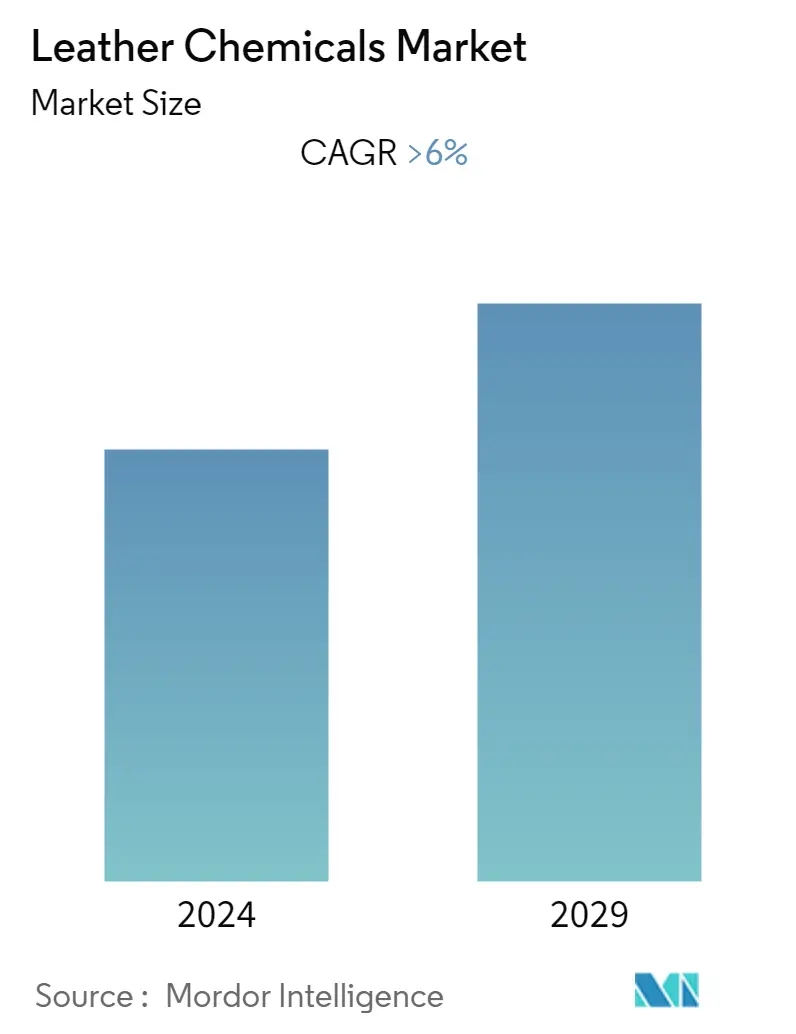Market Size of Leather Chemicals Industry

| Study Period | 2019 - 2029 |
| Base Year For Estimation | 2023 |
| CAGR | > 6.00 % |
| Fastest Growing Market | Asia Pacific |
| Largest Market | Asia Pacific |
| Market Concentration | High |
Major Players*Disclaimer: Major Players sorted in no particular order |
Leather Chemicals Market Analysis
The market for leather chemicals is anticipated to register a CAGR of more than 6% during the forecast period.
COVID-19 severely impacted industry growth in 2020 due to the disruption in the supply chain and the lack of labor. However, surging automotive production in various countries propelled leather chemicals consumption after the pandemic.
- Increasing demand for automotive upholstery and growing footwear and textile industries in Asia-Pacific are augmenting the market's growth.
- Growing environmental concerns, stringent regulations, and high operational costs will likely hinder the market's growth.
- Ongoing research to develop bio-based, eco-friendly products is projected to act as an opportunity for the market in the future.
- Asia-Pacific dominates the global leather chemicals market due to China and India's rising automotive production.
Leather Chemicals Industry Segmentation
Leather chemicals are chemical substances used during various steps of the leather-processing, such as beam house, tanning, dyeing, and finishing. These substances are necessary to give the leather the desired qualities, including durability, softness, and water resistance. The market is segmented into product type, end-user industry, and geography. By product type, the market is segmented into tanning and dyeing chemicals, beam house chemicals, and finishing chemicals. By end-user industry, the market is segmented into footwear, furniture, automotive, textile and fashion, and other end-user industries. The report also covers the market size and forecasts for the leather chemicals market in 16 countries across major regions. The market sizing and forecasts for each segment are based on value (USD million).
| Product Type | |
| Tanning and Dyeing Chemicals | |
| Beam House Chemicals | |
| Finishing Chemicals |
| End-user Industry | |
| Footwear | |
| Furniture | |
| Automotive | |
| Textile & Fashion | |
| Other End-user Industries |
| Geography | ||||||||
| ||||||||
| ||||||||
| ||||||||
| ||||||||
|
Leather Chemicals Market Size Summary
The leather chemicals market is poised for significant growth, driven by increasing demand in the automotive, footwear, and textile industries, particularly in the Asia-Pacific region. The market experienced setbacks due to COVID-19, which disrupted supply chains and labor availability, but has since rebounded with the surge in automotive production. The rising demand for automotive upholstery and the expanding footwear and textile sectors in countries like China and India are key factors propelling market expansion. However, the industry faces challenges from environmental concerns, stringent regulations, and high operational costs. Despite these hurdles, ongoing research into bio-based and eco-friendly products presents future opportunities for market growth.
The application of leather chemicals is crucial in enhancing the durability and texture of leather, making it suitable for various uses in the textile and automotive industries. The increasing global population and shifting fashion preferences are boosting the textile industry's demand for leather. China and India are leading producers and exporters of textiles, with significant contributions to global trade. India's burgeoning automotive and footwear industries further bolster the demand for leather chemicals, with the country becoming a major player in the global market. The market is partially consolidated, with major players like Stahl International BV, Dystar Singapore Pte Ltd, and Lanxess holding substantial shares. Recent collaborations, such as LANXESS's partnership with TotalEnergies, highlight the industry's shift towards sustainable solutions.
Leather Chemicals Market Size - Table of Contents
-
1. MARKET DYNAMICS
-
1.1 Drivers
-
1.1.1 Growing Footwear and Textile Industries in Asia-Pacific
-
1.1.2 Increasing Demand for Automotive Upholstery
-
-
1.2 Restraints
-
1.2.1 High Operational Cost
-
1.2.2 Growing Environmental Concerns and Stringent Regulations
-
-
1.3 Industry Value Chain Analysis
-
1.4 Porter's Five Forces Analysis
-
1.4.1 Bargaining Power of Suppliers
-
1.4.2 Bargaining Power of Consumers
-
1.4.3 Threat of New Entrants
-
1.4.4 Threat of Substitute Products and Services
-
1.4.5 Degree of Competition
-
-
-
2. MARKET SEGMENTATION (Market Size in Value)
-
2.1 Product Type
-
2.1.1 Tanning and Dyeing Chemicals
-
2.1.2 Beam House Chemicals
-
2.1.3 Finishing Chemicals
-
-
2.2 End-user Industry
-
2.2.1 Footwear
-
2.2.2 Furniture
-
2.2.3 Automotive
-
2.2.4 Textile & Fashion
-
2.2.5 Other End-user Industries
-
-
2.3 Geography
-
2.3.1 Asia-Pacific
-
2.3.1.1 China
-
2.3.1.2 India
-
2.3.1.3 Japan
-
2.3.1.4 South Korea
-
2.3.1.5 Rest of Asia-Pacific
-
-
2.3.2 North America
-
2.3.2.1 United States
-
2.3.2.2 Canada
-
2.3.2.3 Mexico
-
-
2.3.3 Europe
-
2.3.3.1 Germany
-
2.3.3.2 United Kingdom
-
2.3.3.3 Italy
-
2.3.3.4 France
-
2.3.3.5 Spain
-
2.3.3.6 Rest of Europe
-
-
2.3.4 South America
-
2.3.4.1 Brazil
-
2.3.4.2 Argentina
-
2.3.4.3 Rest of South America
-
-
2.3.5 Middle East & Africa
-
2.3.5.1 Saudi Arabia
-
2.3.5.2 South Africa
-
2.3.5.3 Rest of Middle East & Africa
-
-
-
Leather Chemicals Market Size FAQs
What is the current Leather Chemicals Market size?
The Leather Chemicals Market is projected to register a CAGR of greater than 6% during the forecast period (2024-2029)
Who are the key players in Leather Chemicals Market?
Elementis PLC, Lanxess, Stahl International BV, Clariant and DyStar Group are the major companies operating in the Leather Chemicals Market.

